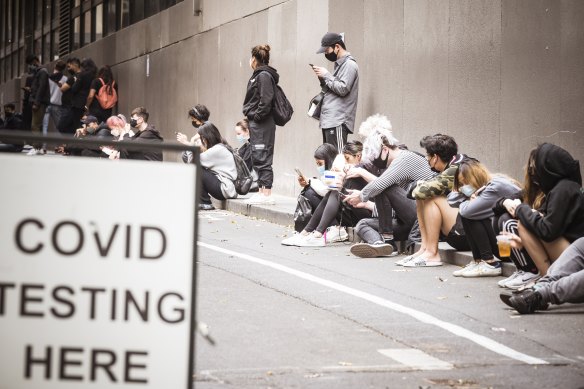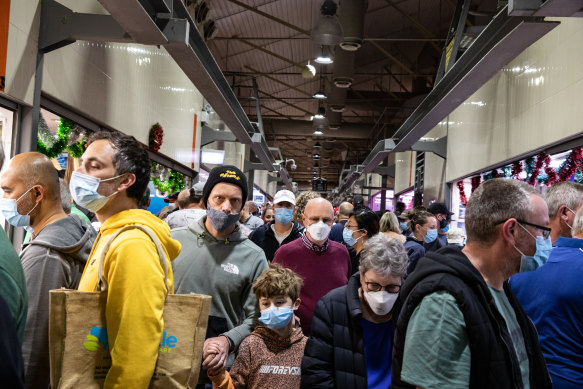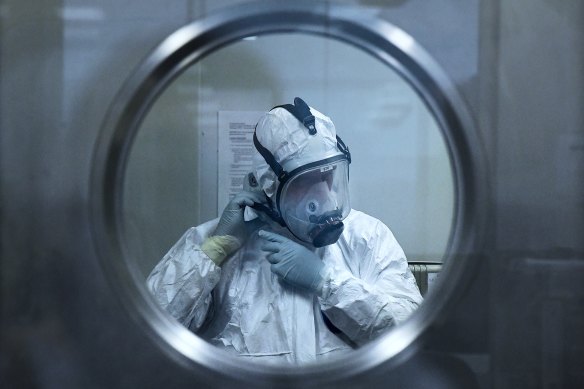The next COVID wave is here. Here’s what you’re in for

By Liam Mannix
We’re in the waning months of 2022, and once again COVID-19 cases are on the rise. A new wave is here, driven by a virus that has devolved into a menagerie of variants, each wielding new tools to unpick our immune defences.
Our political leaders, meanwhile, appear keen to move on. NSW Premier Dominic Perrottet led the charge to end isolation, while Victorian Premier Daniel Andrews declared last month the “era of COVID exceptionalism” over; with the state’s election fast approaching the health department rejected multiple requests to make Chief Health Officer Brett Sutton available for interview.
Responsibility for pandemic decision-making has shifted from Brett Sutton to the Andrews government.Credit:Eddie Jim
But the virus remains with us: it has killed 798 Australians since the start of October, the equivalent of crashing two fully-laden 747s. Tens of thousands of Australians suffer from life-upending severe long COVID.
To get a sense of the state Australia is in as we head into our next wave, The Age spoke to more than a dozen experts across epidemiology, genomics, vaccination, treatment, hospitalisation, aged care, paediatrics and long COVID. Two key takeaways emerge:
Scientific evidence and local data has given many experts confidence the current wave – and future ones – won’t cause tremendous loss of life. Healthcare is not inundated. Epidemiologists who spoke to The Age did not call for new restrictions.
Instead, the pandemic’s effects are increasingly concentrated on certain groups: people in aged care and the immunocompromised.
And the exception to this remains long COVID – a debilitating condition that seems to strike down the healthy almost at random, and for which our healthcare system is entirely under-resourced for.
THE WAVE
Today, we are in the middle of Omicron’s fourth Australian wave: cases have been climbing since early October.
Official modelling predicts cases in NSW and Victoria will peak around early December.
This wave, epidemiologists said, should hopefully represent the new normal of COVID in Australia: a major uncoupling of infections from hospitalisations and deaths. Case numbers will rise and fall but our immunity means we should not see large waves of death. We are finally stepping off the roller-coaster.
“I suspect we probably will see a significant wave of transmission and some increase in hospitalisation and deaths, but we will be protected by the substantial population immunity we now have, and the effects of the wave should be smaller than the previous ones,” said the head of Monash University’s epidemiological modelling unit Associate Professor James Trauer.
We should escape the large-scale deaths caused by Omicron in 2021 and 2022.
“Why? Because: we are all getting more immunity from natural infection, even if vaccine uptake is falling and immunity is waning in the population,” said University of Melbourne epidemiologist Professor Tony Blakely. “The new variants – so far – do not look too severe in terms of hospitalisation or death.”
Queues of people outside a testing site in Melbourne earlier this year.Credit: Chris Hopkins
The demise of our testing system – it’s no longer mandatory to even report a rapid-antigen test – means we don’t have as clear a picture of the ebb and flow of the pandemic as we once did. The true number of cases is perhaps five to 10 times higher than the numbers report, said Professor James McCaw, a leading COVID-19 adviser to the federal government.
But epidemiologists told The Age they remained confident in the data, which is supplemented with population surveys and wastewater testing; those signs accurately foretold of the current wave. “We can still draw a reasonably accurate picture of the current trend,” said McCaw.
Australia managed to avoid high levels of virus transmission until late 2021, by which point most of the population was vaccinated – preventing enormous numbers of deaths. The virus came for us late, but it still came: 85 per cent of Australia’s COVID-19 deaths have been recorded this year, killing 13,714 people.
To put this in context, cancer – our leading cause of death – claims about 4000 lives a month. Heart disease claims about 1200.
More than 50 per cent of these deaths have been in people aged over 80; less than 6 per cent have been in people aged under 59. Some 76 per cent of people who died up to July this year had an underlying chronic condition.
The virus remains one that spares the rich and attacks the poorest members of our society. People in the lowest socio-economic group are twice as likely to die from the virus as those in the richest, Australian Bureau of Statistics data shows.
A key factor in preventing deaths from COVID-19 is preventing health system overload. When hospitals come close to or exceed their ICU capacity, a lot of people die – not just from COVID but from everything. This is the scary maths that compelled us to lock down in 2020 and 2021.
Australia’s hospitals are in relatively good shape compared to our Omicron peaks in January and July. In January, almost a quarter of Victoria and NSW’s ICU beds were taken up by COVID patients; that number is now close to 4 per cent.
“COVID is really not a major issue in ED right now. The vast majority are not getting critically unwell with it,” said Dr Clare Skinner, president of the Australasian College for Emergency Medicine. “We now have several treatments that work. We have a handle on how to medically manage COVID we did not have at the start of the pandemic.”
RESTRICTIONS, VACCINES AND VARIANTS
NSW and Victoria ended their pandemic declarations in early October. After years of masking, isolation, vaccination and lockdown, the states run with essentially no checks on the virus’s spread.
McCaw, Blakey and Trauer – all whom have contributed official epidemiological modelling – said the current restrictions in Victoria and NSW were broadly appropriate.
“The situation is muted compared to all earlier waves,” said McCaw. But, said Blakely, we need to be ready to return to restrictions if things start to get really bad. “We have to be prepared to retreat a little.”
Masks, once ubiquitous across Sydney and Melbourne, are now rarely seen.Credit:Getty Images
Those pandemic-era restrictions have not often been replaced with sustainable measures. Air quality scientists fought and won the battle to recognise that COVID-19 can spread through the air – but, almost three years into the pandemic, Australia still lacks a serious effort to improve indoor air quality.
“We are an educated society, we know how infection spreads,” director of the International Laboratory for Air Quality and Health Professor Lidia Morawska told InSight+. “Compare it to, spitting into a public fountain – everybody would jump at this. ‘What are you doing?’ How come polluting water with pathogens attracts this attention, but not air?”
We live with a new disease now, that will – even in good times – add to the number of sick people every year, and possibly increase the risk some people have of developing other major chronic health conditions. Added on top is the health system burden of caring for people with long COVID.
All this will require a hugely-beefed-up healthcare system, said Grattan Institute health program director Dr Stephen Duckett, from GPs all the way up to long COVID clinics. Current federal health funding growth is capped at 6.5 per cent. “If the 6.5 per cent rate was reasonable in a pre-long COVID environment, it is certainly not reasonable now,” he wrote in a submission to a federal inquiry into the disease.
Australia’s most-lethal COVID-19 wave was caused by Omicron; the current wave is being driven by the virus’s children. There’s BA.2.75, BA.5, BQ.1, XBB, and BA.2 – and that’s just what we detected last week.
These variants are now so diverse they are starting to recombine with each other and produce yet more children. A recombinant of BA.2.75 and BA.5, christened XBF, was discovered in Victoria earlier this month.
Associate Professor Stuart Turville dons protective equipment before starting to work with COVID-19 variants.Credit:Kate Geraghty
This is a feature long-predicted by virologists. “The more people are infected, the more viruses get to be produced, the higher the chance for random mutations to occur that are functional,” said Dr Denis Bauer, a CSIRO scientist building machine learning models to track new variants.
So far, there are no signals to suggest any of these variants cause more-severe disease. Dr Norelle Sherry, a medical microbiologist at the Doherty Institute and a member of the national Communicable Diseases Genomics Network variant of concern taskforce, has even started to grow cautiously optimistic we may not soon see another extremely bad variant.
“We’re a bit more reassured by the fact we haven’t seen increased disease severity despite seeing many, many, many variants coming out,” she said. Obviously we can’t rule it out, but it does seem to be less likely at the moment.”
Why hasn’t a single variant become dominant, a la Alpha or Delta? Because there are so many infections locally and globally. That’s generating an enormous number of mutations – and these mutations are starting to converge on the same spots, finding the same chinks in our armour.
This has two effects. First, because there are now so many variants with very similar mutations, it becomes difficult for one to become dominant – hence the variant soup we live in.
“I am concerned about booster uptake”
Second, these variants have now evolved very high levels of evasion to our vaccine-and-infection-generated immune defences.
A study that has not yet been peer reviewed, uploaded in October, estimated BQ.1.1.10, BA.4.6.3, XBB, and CH.1.1 were the most-antibody-evasive variants ever tested (a mark almost-certain to be superseded soon).
“The degree of immune escape and evasion is amazing right now, crazy,” Yunlong Richard Cao, an immunologist at Peking University in Beijing and the paper’s author, told Nature.
Exactly how immune are we to these variants? It is hard to know.
Early in the pandemic scientists could build excellent models of just how immune a person might be after vaccination. Not so now. People have different numbers of jabs, made by different companies. Some people have been infected once, some several times, all by different variants. How does AstraZeneca + Pfizer x 2 + Delta infection compare to, say, Pfizer x 4 + Alpha + Omicron? No one knows.
And we know vaccine protection wanes over time. “On average, we think you lose about half your immunity about every two to three months,” said the Kirby Institute’s Dr Deborah Cromer, who has been studying the effectiveness of boosters against COVID-19.
But we don’t just have to rely on vaccines alone. Australia’s huge wave of Omicron infections should now provide us with good protection against the children-of-Omicron.
Even if the new variants do slip our defences and infect us, our vaccines – and prior infection – continue to provide excellent protection against getting seriously ill or dying, said Dr Adam Wheatley, a University of Melbourne researcher studying immune responses to COVID-19. A study in Lancet Microbe tracked more than 200,000 people who either had prior immunity or had been vaccinated; over almost a year and a half just 16 got seriously ill from COVID, and no one died, despite almost 8000 recorded infections.
This is part of the reason behind health authorities declining to recommend a fifth booster – four seem to provide strong protection with a fifth showing little benefit. Some 72.3 per cent of eligible people have had a third booster; about 80 per cent of people over 75 – the crucial at-risk bracket – have had a fourth dose.
That’s not as high as many would like. “I am concerned about booster uptake,” said Associate Professor Margie Danchin, leader of the vaccine uptake group at the Murdoch Children’s Research Institute. “We’ve got 70 per cent – and that’s remained pretty stagnant, it hasn’t shifted.”
THE VULNERABLE
“That being said, one aspect that seems a bit overlooked is that these newer lineages appear resistant to Evusheld,” said Wheatley.
The injectable antibody cocktail is a key shield protecting people whose bodies do not respond strongly to vaccination, like those with suppressed immune systems.
New COVID variants show strong signs of being able to entirely evade its protection.
“COVID [is] trying to kill the weak – and I’m the weak,” healthcare worker Holly told The Age earlier this month. With a primary immune deficiency, “Evusheld is a brick in the wall that’s protecting me”.
Without its protection, Wheatley feared we may see the toll of the pandemic fall more heavily on people who are immunocompromised. “And there is no other substitute available at present.”
Holly, like many Australians with compromised immune systems, relies on Evusheld to help protect her from COVID-19.
Serosurveys, which test blood for COVID-19 antibodies, revealed earlier this month that more than two-thirds of those aged under 18 have been infected with the virus.
Thankfully, this has not translated into widespread severe disease or death among children – it seems very rare for kids to get seriously ill. Early evidence suggests they face very low and possibly-negligible risks of long COVID. “We are not seeing a huge number of long COVID cases – it is absolutely amazing how low the numbers are,” said Margie Danchin, who also worked as a paediatrician at the Royal Children’s Hospital in Melbourne.
Deaths in aged care no longer capture headlines as they did when 45 people died at St Basil’s Homes for the Aged in 2020.
Yet aged care remains COVID’s favoured hunting ground. Since Omicron emerged in November 2021 almost a quarter of Australia’s total deaths from the disease have been in aged care.
But context is important. This figure represents just 5.5 per cent of all deaths in residential aged care.
Aged care facilities had significantly improved their infection control since early in the pandemic – and vaccines had helped enormously, said Ian Yates, chief executive of Council on the Ageing Australia. Older people were aware they were at risk and were taking steps to stay safe. “I think people need to respect that,” he said. “If they are going to be in contact with older Australians, perhaps consider those behaviours. Because the consequences can be quite nasty.”
While older Australians understand their risk, younger people may not have a clear picture of the risks they face of developing long COVID should they get infected.
The true risk, and how long the disease lasts for, remains extremely uncertain – but given almost everyone will be infected, even a small risk can produce a very large burden of disease.
Official Victorian government modelling puts the number of people in the state with severe long COVID at 41,000. Just-released Deakin University modelling puts the current number of people nationally with severe long COVID at between 64,474 and 196,797.
“I don’t think most people really understand, they have got something like a one in 20 chance of developing a disability they may not ever recover from, not be able to work for a year,” said Elise Jones, who developed long COVID after catching the virus on New Year’s Eve.
She called for national messaging warning people of the risks. “If they are making the decision to open everything up… I just think there’s the ethics to consider.”
And access to services remain abysmal, with some clinics running waiting lists of almost a year and others closing due to lack of funding.
“People think if they have had COVID once, they’ll be OK,” said Jones. “I just don’t want anyone else to end up in the situation I’ve ended up in, because it’s so horrible.”
The Morning Edition newsletter is our guide to the day’s most important and interesting stories, analysis and insights. Sign up here.
Most Viewed in National
Source: Read Full Article




